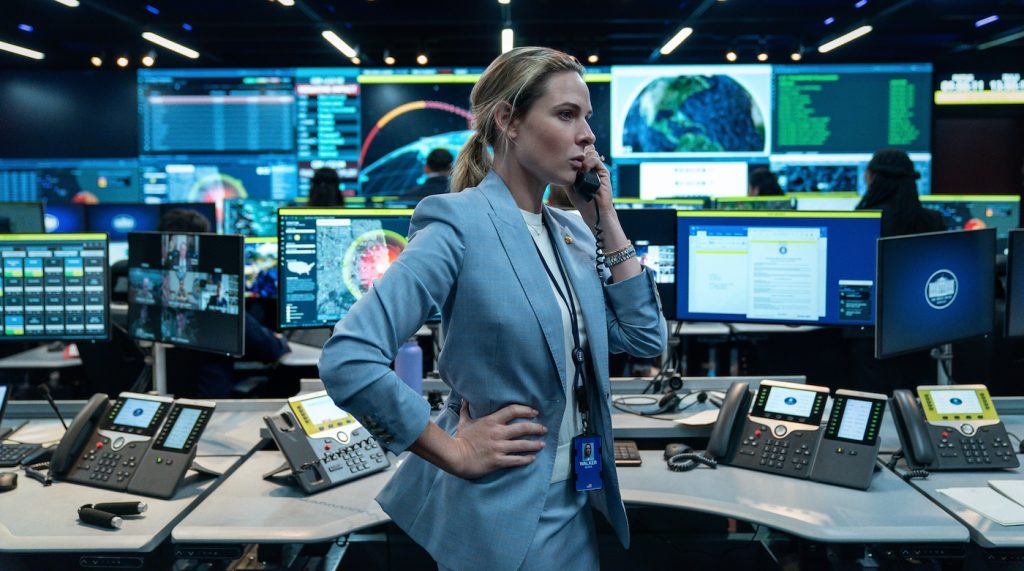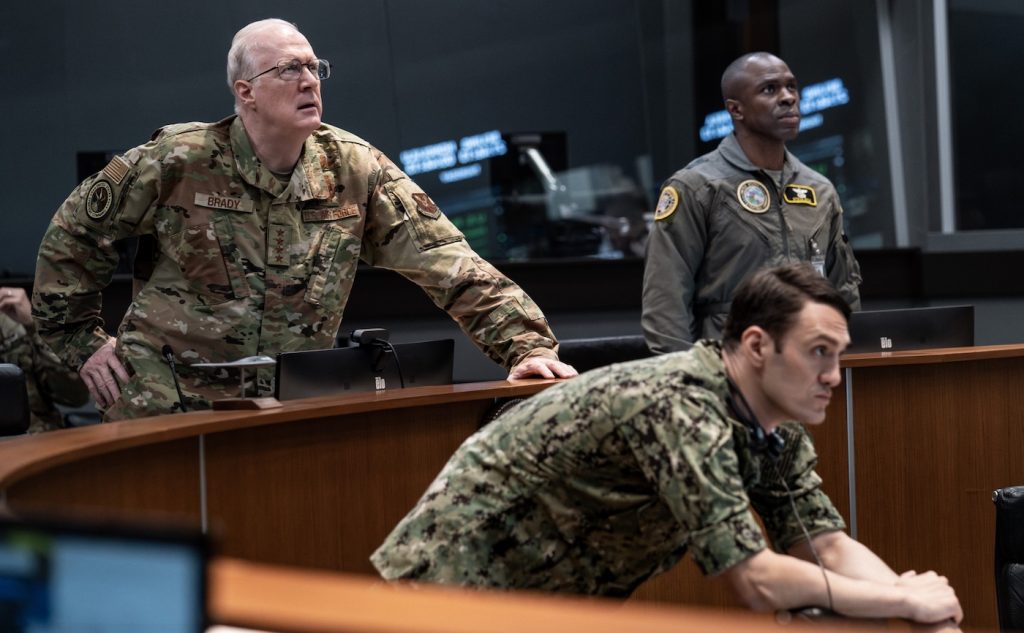Inside “A House of Dynamite”: Production Designer Jeremy Hindle on Building Kathryn Bigelow’s Nuclear Thriller
An unrelenting, blistering thriller that grips you from the first frame and never lets go, Oscar-winning Kathryn Bigelow’s latest film , A House of Dynamite, is the final installment in a trilogy that began with 2008’s The Hurt Locker and continued with 2012’s Zero Dark Thirty. Continuing her trademark journalist approach to filmmaking and fascination with the military industrial complex, A House of Dynamite follows high-ranking officials in the U.S. government as leaders in the military, intelligence, and White House scramble during the 20 minutes before a nuclear missile incinerates a major U.S. city, with the same events replayed from three POVs over the film.
It is a sobering look at how the response to a nuclear attack might unfold at the highest levels, with nail-biting decisions made at several locations: the 49th Missile Defense Battalion in Fort Greely, Alaska, where Major Gonzalez’s (Anthony Ramos) crew is tasked with detecting and neutralizing incoming nuclear threats; US STRATCOM (Strategic Command), where General Brady (Tracy Letts) advises POTUS on missile defense; the 24/7 “Watch Floor” intelligence center in the White House Situation Room run by Rebecca Ferguson’s Captain Olivia Walker; and the PEOC (Presidential Emergency Operations Center), a secured communications center underneath the White House in the event of catastrophic emergencies. It was a Herculean task for production designer Jeremy Hindle — who recently won an Emmy for the Apple TV series, Severance — “because all the main sets had to be ready for day one, since we shot many sets simultaneously. Every set had to be live and ready to go with full ceilings and 360-degree access,” he reveals.
Filmed primarily on soundstages in New Jersey, the film received $30 million in tax credits after incurring $75 million in qualifying expenditures across six counties. “New Jersey’s tax credit is pretty spectacular; they’re all on board for people filming there. One of the state trooper commanders said he’d been instructed to help us in any way he can,” Hindle said, praising the exceptional assistance from the New Jersey State Police. “I was looking for a place to film a helicopter on a tarmac, a huge hangar for a B-2 bomber, and a helicopter pad where I can land a Black Hawk. They took me around with a police escort to scout all those locations. In one day, we had the locations we needed, which was amazing! We got to film at the Governor’s helipad in Trenton, the only place you can land a real Black Hawk!”
With significant overlap with the Severance crew, Hindle reunited with set decorator David Schlesinger, supervising art director Chris Shriver, and art director Ann Bartek. He recently spoke to The Credits about his third collaboration with Bigelow (following Zero Dark Thirty and Detroit).
First of all, congratulations on the Emmy win for Severance!!
Thank you! That was a fun time, just amazing.
What was it like to work on your third Bigelow project?
I love how she thinks, which enables me to serve her movies in a way that allows me to do exactly what I feel should be done. She has so much trust and gives you the ability to do it. She’s an amazing collaborator. When she calls me to make a film, I know it’s important. I like making all kinds of movies, but this film makes people talk and think and hopefully make things better. She really cares about using her voice, and I love being a part of that.
You’re also a producer on this. How was it different than when you’re strictly designing?
It’s not all that different. I like to be as involved as possible. I started when we got the script with Kathryn and [producer] Greg [Shapiro] budgeting. It’s great when designers are involved at the beginning to help decide how you’re going to make the movie before it’s budgeted. Even though the script is straightforward with people talking on the phones, I quickly realized it wasn’t simple at all. Every character at the different locations is acting against other people on the screens in real-time. Kathryn Bigelow isn’t gonna let her actors act with tennis balls and blue screens; it’s just not how she works — she wants realistic performances. So, we had to build it all on stage; 80% of the movie was on stage, and every set had to be authentic.
The nail-biting urgency in real-time came through in every frame — it engulfs you into the nightmare scenario.
The story is so important that you don’t want audiences to dismiss it if it doesn’t look accurate and authentic. The point is to get people to have this conversation about nuclear proliferation and really understand how terrifying the reality is.
How big was your team? Were they mostly local in the Tri-state area?
It was mostly the same crew from Severance. I rolled in from that to this. I had the dream team that I’d worked with over the years in New York. Chris is the greatest — a 40-year veteran of film in New York. I don’t think I could’ve done this without him. When you walk onto the set with Kathryn and [cinematographer] Barry [Ackroyd], it’s pretty much lit like a location. We had the biggest art department I’ve ever had because there were so many sets.
What about sourcing materials for all these sets? How much was fabricated in-house?
We had an amazing construction team, and the set dec team was big — a lot of stuff had to be fabricated to match everything. For the standing desks in the White House Situation Room with robotics that can move, our amazing decorator David [Schlesinger] sourced them from the same manufacturer that makes the real ones. The chairs in the White House press briefing room were made in Spain by the same company that makes the real ones, so they’re identical. After touring the White House press room, I knew it had to be the same. This is our job – why not be perfect? If you’re going to do it, do it right.

What was it like designing and building the 360-degree sets?
With Kathryn, you don’t know how she wants to walk in [to the shot]. My job is to create an environment for the actors to play in, so that she and Barry can come in and just let them loose. It feels real; when the generals walked into the STRATCOM set, they were blown away — they wanted to take it as a training facility, it was exactly the same. The Situation Room was the same. On any film set, if the actors aren’t inspired and feel like they’re in the right place when they walk in, then I have failed at my job.
Were you able to access the White House Situation Room for research?
Yes, I got to walk around and memorize what the room looked like for three minutes. I couldn’t have any notes or a camera. There’s a photo behind Rebecca of Neil Armstrong landing on the moon — that’s there in the real room — along with the executive order to take out Osama bin Laden below it. The details are exact. We went to the Pentagon, which was incredible, but I didn’t get to see the Secretary of Defense’s office. I’ve always been fascinated by it — very few people will talk about it, but there are great photos. I have an amazing researcher that I’ve always worked with. We didn’t have DoD access on this project, but several technical advisors guided us. So that’s the only room that we nailed without seeing it. Pretty much every general who walked into that set said it looks exactly like the real thing.

You also toured STRATCOM in Oklahoma with the former chief of staff at that facility, retired U.S. Army Lieutenant General Daniel Karbler, who joined as one of the technical advisors. Why is authenticity crucial for this film?
This film isn’t about the military being efficient and ready. They’re ready — we are not ready and are not making good decisions. Going underground into STRATCOM was amazing. We were already building it by then, based on 3-4 photographs released when it first opened. However, there were no details in the photos because they had all been scrubbed. I had 11 minutes, no camera, and I just memorized every detail in the room. “The big board” from Dr. Strangelove was really there; the general at the time put that up. The people who work there train 400 times a year for this exact thing. They are so prepared and smart. After meeting them, I felt so safe. They believe in nuclear as a deterrent and will do anything to make the country safe. They’re just amazing people.
Check out part two of our interview here.
A House of Dynamite is streaming on Netflix.
Featured image: A House of Dynamite. Anthony Ramos as Major Daniel Gonzalez in A House of Dynamite. Cr. Eros Hoagland/Netflix © 2025.



